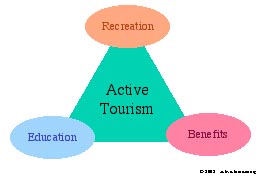 Components of Active Tourism
Components of Active Tourism
Active Tourism is a special way to spend your vacations. It is a new travelling philosophy that combines adventure, ecotourism and cultural aspects of a discovery tour. Active tourism is low-impact, ecological, socially compatible and high quality. Active tourism has three major aims:
![]() Recreation: distraction from daily working routine during vacations. Active tourism is fun and can provide you all the pleasure you can desire. Relax your mind and recharge your body energy by practising exercise and actively participating in your entertainment.
Recreation: distraction from daily working routine during vacations. Active tourism is fun and can provide you all the pleasure you can desire. Relax your mind and recharge your body energy by practising exercise and actively participating in your entertainment.
![]() Education: An active tourist is eager to learn and wants to know closely another culture and way of living. Your vacations should broaden your horizons. Willingness to learn the language, eat the tipical food, value local traditions and respect foreign cultures and beliefs.
Education: An active tourist is eager to learn and wants to know closely another culture and way of living. Your vacations should broaden your horizons. Willingness to learn the language, eat the tipical food, value local traditions and respect foreign cultures and beliefs.
![]() Benefit: Tourism not only brings advantages to visitors but also helps the local economy and promotes development of the visited land. Active tourism is low impact, ecologically and socially sustainable. Active tourism uses and values nature, protects biodiversity and offers work to people.
Benefit: Tourism not only brings advantages to visitors but also helps the local economy and promotes development of the visited land. Active tourism is low impact, ecologically and socially sustainable. Active tourism uses and values nature, protects biodiversity and offers work to people.

The best way to visit a land is to travel with a local friend that shows you all the beautiful and interesting attractions. Somebody that explains you about local costumes, traditions, about history, art and culture. Somebody that takes you to eat tipical food, shows you where to shop and takes you around. A friend that shows you the local nature and takes you into adventure. This is the most authentic way to visit a foreign country.

